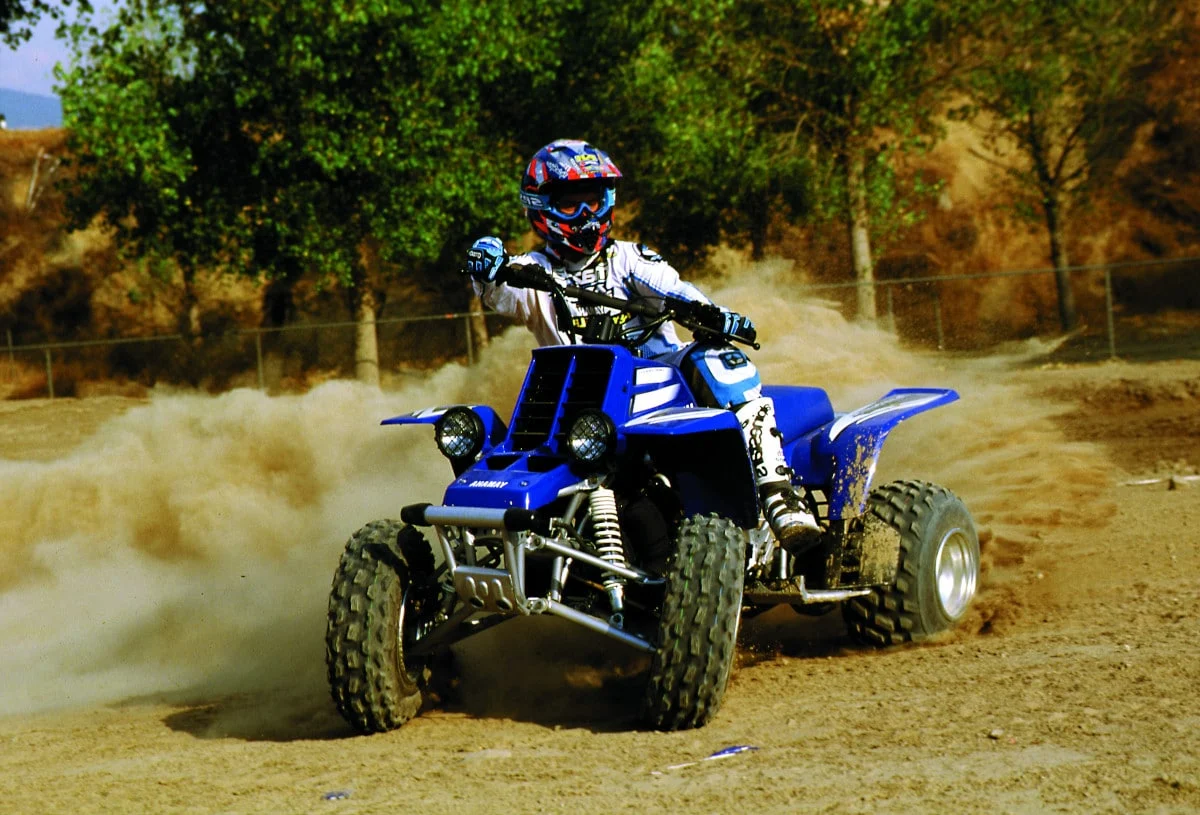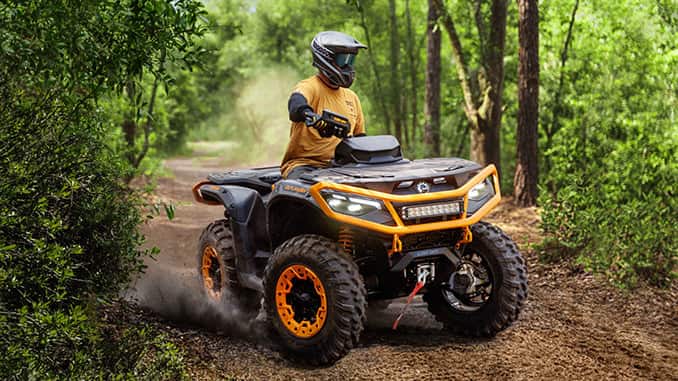Table of contents
Toggle- Two Classes, One Vision: Can-Am Reinvents ATVs and Quads
- The New Outlander’s G3L Chassis
- Engine: Brand New for 2023!
- Transmission
- Overview of the Test Vehicle: The Pro XU HD5, a Featured Utility Model
- Look & Ergonomics
- Comfort and Ergonomics: Riding Position Analysis
- Summary of the Test: What to Remember About the Can-Am Outlander Pro XU HD5 2023
- Improvements Over the G2 Chassis
- Desired Improvements on the Outlander Pro XU
- Conclusion of my Outlander Pro XU Review
- If you like Can-Am, here are some more articles about them:
On February 20th, Can-Am took us by surprise with the announcement of an entirely new range of ATVs. This summer, I had the opportunity to cover over 900 km with the Pro-XU HD5 model. Here are my impressions.
Two Classes, One Vision: Can-Am Reinvents ATVs and Quads
This new ATV lineup undoubtedly represents Can-Am most significant announcement since the release of the second-generation platform in 2012, also known as G2. In my opinion, Can-Am is completely redefining its entry and mid-range segments. So, what’s new in this lineup? Quite a lot: a new chassis, a new engine, a new transmission, and new technologies. Everything has been redesigned.
That’s why the company has created two entirely separate categories. We also aim to offer a range of reliable quads that are easy to maintain, with longer maintenance intervals. Our goal is to enhance our competitiveness in terms of pricing compared to other manufacturers.
Cost Reduction, Quality Enhancement
Here we observe the addition of recreational models that almost replace the previous 450 and 570 models that were available. These new models include the 500 2WD, the 500/700 series, DPS (500/700), XT 700, X MR 700, MAX DPS (500/700), and MAX XT 700. Additionally, a new utility range called PRO has been introduced, including the PRO XU and the PRO-Hunting Edition as standard, both available with HD5 or HD7 engines.
Now, how did Can-Am managed to reduce production costs while improving reliability? It’s rather simple:
- By using machined parts that have been shared across different platforms for many years and have proven to be highly reliable.
- By simplifying some technologies, such as transitioning from a twin-cylinder engine to a single-cylinder engine.
- By deciding to replace some parts with others that are less expensive while maintaining the quality of the final product.

The New Outlander’s G3L Chassis
The all new third-generation Outlander chassis, known as the G3L, marks a significant evolution from the previous G2 generation models. It’s a completely redesigned tubular frame that radically departs from the G2 frame design. Furthermore, it’s paired with a double A-arm suspension, both at the front and rear.
This design improves ground clearance, ranging from 12 inches on some models to 13 inches for the PRO-models. Another major innovation is the use of dual-tube shocks. The suspension offers 9.75 inches of travel at the front and 10.25 inches at the rear. It’s worth noting that the PRO model features a stiffer suspension with specific springs aimed at increasing traction during towing.

Engine: Brand New for 2023!
It’s a 650 cc single-cylinder engine. This brand-new engine will be used in all the versions mentioned earlier in this article. So, what’s the difference between the 500, 700, HD5, and HD7? Essentially, not much, except for model-specific computer calibration. Additionally, the 700 and HD7 models feature a more aggressive and high-performance camshaft. Usually, the numbers refer to the vehicle’s displacement.
With these new variants, Can-Am deviated from this standard, so we can no longer identify the displacement by the number on the vehicle, which I find a bit unusual.

Engine Comparison: More Power for Can-Am Models
What are the performance figures for this engine?
For the 500 models and the HD5 version, the power reaches 40 horsepower, and the torque is 37 lb ft. As for the 700 model and the HD7 version, power goes up to 50 horsepower, and torque reaches 41 lb ft. So, if we compare these figures with the 450 single cylinder and the 570 V-twin engines they replace, the new models deliver more power. Moreover, based on the information I found online, the torque of the new 700 cc engine is even higher than that of the 570 cc V-twin engine it replaces.
In summary, this new engine boasts very promising characteristics. Given that the single cylinder is a simpler engine and is shared across different platforms, I am inclined to believe that its long-term reliability will be excellent.

Transmission
For all these new Outlander models, Can-Am has overhauled the CVT transmission. In this regard, Can-Am incorporating the pDrive primary pulley, among other improvements. With the use of rollers, this pulley will provide better accelerations and smoother gear changes. Additionally, it’s a more reliable and robust system that is also more cost-effective to maintain.
It’s worth mentioning that this technology is not new and has been used for a long time in Ski-Doo vehicles and has recently been integrated into some types of side-by-side vehicles. In this regard, I am confident that this mechanism has been thoroughly tested over a sufficiently long period to offer a high level of reliability.
Overview of the Test Vehicle: The Pro XU HD5, a Featured Utility Model
First and foremost, this is the Pro XU HD5 utility model. This model comes with a 40 hp calibration. It features arched front and rear suspension with twin-tube shocks and stronger springs. It has a ground clearance of 13 inches. Among its features are 3-mode power steering, a speed limiter, and an Intelligent Engine Braking (IEB) system.
We can then discuss the front differential lock system (Visco-4Lok), front and rear bumpers, as well as the full-vehicle skid plate. Additionally, it comes with an “Extra Low” mode that will be available on all Pro models, along with calibration specifically designed for professional tasks.

The New Model vs. Its G2 Predecessor
I decided to compare this vehicle to one of its G2 platform predecessors, namely the Outlander 650 XT. The new vehicle is longer and wider than its predecessor but slightly shorter (dimensions: length 89.9 x width 48.8 x height 48.2 inches). The wheelbase is slightly longer, increasing from 51 to 53 inches. It comes equipped with 12-inch Trail King tires mounted on aluminum wheels, whereas the previous models had 14-inch tires. The fuel tank has lost 0.9 liters, now at 19.5 liters.
It’s essential to highlight the impressive 34-liter storage capacity compared to the previous 21.4 liters. Furthermore, the front and rear rack capacities have been increased to 120 pounds at the front and 240 pounds at the rear. The vehicle’s announced weight is 816 pounds, which surprised me since the 650 XT weighed 749 pounds. Nevertheless, the towing capacity has been significantly improved, going from 1675 pounds to 1830 pounds.
Look & Ergonomics
I greatly appreciate the design of this new model, especially the front of the vehicle. Although I’m not a big fan of rectangular headlights, I can’t complain because they are LED. Whether you look at the vehicle from the front or rear, you can find numerous design elements reminiscent of older models, including the wheels.
On the XU model, I particularly like the front bumper, which reminds me of the older XT models. I also find the new front rack design very successful. Concerning the overall finish and assembly quality, they are simply impeccable.
Comfort and Ergonomics: Riding Position Analysis
When you sit in the vehicle, the first thing I notice is the knee and foot clearance. The riding position is comfortable, with the body and legs well aligned. The buttons are placed in the same locations as on the older models, except for the speed limiter and engine brake buttons, which are located at the rear. It’s worth noting that the 500 Pro XU HD5 model uses a D.E.S.S. key for ignition.

Summary of the Test: What to Remember About the Can-Am Outlander Pro XU HD5 2023
Within the first few minutes, I am genuinely excited about this quad. There is absolutely no doubt that we are indeed sitting on a Can-Am Outlander Pro XU HD5 2023, easily recognizable by its overall behavior. To start with, the engine delivers good performance, as does the continuously variable transmission (CVT).
I should note that the engine isn’t excessively noisy, especially at low revs. Although it’s not a performance-oriented vehicle, I find it immensely enjoyable to ride. Acceleration is brisk, and the throttle response is satisfying.
Driving Performance: Stability, Control, and Comfort
Can-Am engineers have done an excellent job with this new-generation chassis. The result is a stiffer and more stable vehicle. It performs better on rough trails, and the fact that the engine is positioned towards the rear significantly improves the quad’s behavior, making it more balanced.
The slightly wider and longer dimensions of the vehicle, along with the increased wheelbase, also have a positive impact on the ride. The combination of the suspension and shocks offers excellent control and remarkable ride comfort.
Ground Clearance and Suspension: The Perfect Balance on the PRO XU Model
In this context, even though the PRO XU model has a 13-inch ground clearance, it doesn’t negatively affect the handling. I particularly appreciate the use of firmer springs on the vehicle. Moreover, I consider the Visco4Lok mode for locking the front differential indispensable on a utility vehicle like this.
Unfortunately, I couldn’t test towing a trailer or try out the “Extra Low” mode due to circumstances beyond my control, but rest assured that it’s on the horizon. For those who don’t need the front cargo box, the chainsaw mounting bracket is an essential addition.

Improvements Over the G2 Chassis
In comparison with the G2 chassis, here are some other positive points to note. First and foremost, the riding position is excellent. The engine temperature remains stable, and the radiator operates less frequently. We no longer experience the issue of water splashing into the footwells as was the case before, and overall, we are much better protected.
Gear engagement is now more straightforward. Moreover, the front storage space is spacious, quickly making us forget the small rear cargo box of the previous generations.

Ease of Maintenance: Simplified Component Access and Improved Connectors
Regarding the DPS (Directional Power Steering) mode, it works better than before, especially the mode offering maximum assistance. In terms of assembly, the finish is impeccable. A dedicated space has finally been added for switch installation, making it easier to add accessories.
All wires and connectors are better protected and sealed than before. The various panels assemble easily and can be removed quickly. Furthermore, the arrangement of the mechanics allows for easy access to most components, simplifying maintenance.

Desired Improvements on the Outlander Pro XU
Firstly, I noticed that the throttle sensitivity was too high. While I understand that the vehicle is calibrated for work purposes, this doesn’t provide a very pleasant experience on a trail with numerous bumps. The speed limiter functions effectively in maintaining a constant speed.
I would have appreciated the ability for the owner to set a specific speed limit for the vehicle and have sole control over unlocking it.
Why a Winch and Phone Mounting System Would Be Appreciated
The intelligent engine braking (IEB) mode has three settings. Although I tried each mode, I still used the mode with maximum assistance, which provided braking similar to the ATVs I rode in previous years. In this regard, I didn’t find this feature very useful.
For instance, I would have preferred the ATV to be equipped with a winch, given its status as a utility-focused PRO model. The small front storage compartment is handy. Inside this compartment, I would have appreciated the ability to secure the phone with a strap similar to the one in the front cargo box, rather than using a magnet system.
Finally, I suspect that the wheels will be easily damaged because they are not as well protected by the tires as they were before.
Conclusion of my Outlander Pro XU Review
Overall, I truly loved the vehicle during the test. This chassis is simply superb, immediately making you forget about the chassis and ATVs it replaces. The Outlander PRO XU is unequivocally a utility vehicle that I highly recommend to farmers, hunters, and anyone in need of an ATV for work and play.
I’m pleased to announce that I will soon be testing the Outlander 700XT and evaluating its towing capabilities.
A big thank you to BRP and Infoquad.com for this opportunity.









